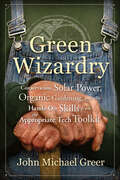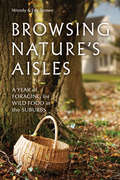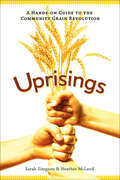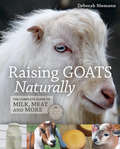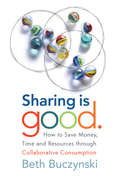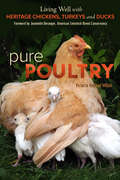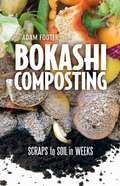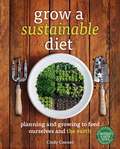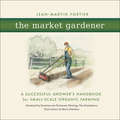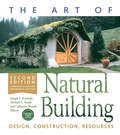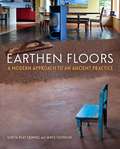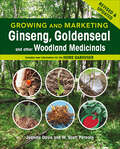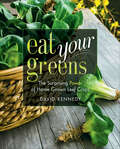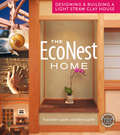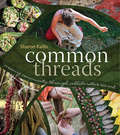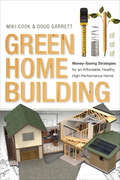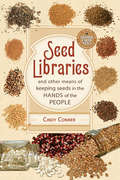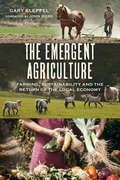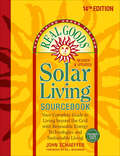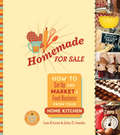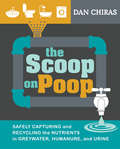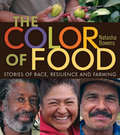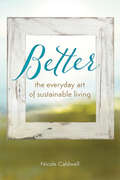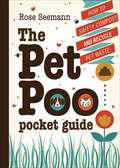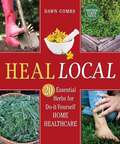- Table View
- List View
Green Wizardry: Conservation, Solar Power, Organic Gardening, and Other Hands-On Skills from the Appropriate Tech Toolkit
by John Michael GreerGreen Wizardry is a hands-on guide to homescale energy conservation, backyard food production and other commonsense responses to scarcity. Written by a veteran of the 1970s appropriate technology movement, it offers tried and tested solutions and a wealth of nearly forgotten practical skills to help individuals, families and communities cope creatively with the end of the age of cheap energy.
Browsing Nature's Aisles: A Year of Foraging for Wild Food in the Suburbs
by Wendy Brown Eric BrownFor most, wild edibles are a passing curiosity - we gather enough summer berries for jam or maybe some stinging nettles for soup or tea. Browsing Nature's Aisles tells the story of how one suburban family committed to increasing their food security by incorporating wild foods as a dietary staple - and proves that you can flourish through foraging too.
Uprisings: A Hands-On Guide to the Community Grain Revolution
by Heather Mcleod Sarah SimpsonUprisings offers practical advice to empower and inspire individuals and community groups interested in growing and eating local grains. Step-by-step instructions on everything you need to know for successful small scale grain production are rounded out by a bushel of case studies demonstrating how to develop a community grain model suitable to any group's unique needs and resources.
Raising Goats Naturally
by Deborah NiemannThere is no one-size-fits-all approach to raising goats (or any livestock for that matter). But by working with nature, you can raise happy, healthy dairy goats and produce your own milk, cheese, meat, fertilizer, leather, fiber and soap -- all without relying on drugs or following the factory-farm model. Raising Goats Naturally will show you how.
Sharing is Good
by Beth BuczynskiCollaborative consumption is a new way of living in which access is valued above ownership, experience is prized over material possessions, and "mine" becomes "ours," allowing everyone's needs to be met with minimum waste. Bursting at the seams with hundreds of helpful tips and valuable resources, Sharing is Good is a practical guide to this new and exciting "sharing economy."
Pure Poultry
by Victoria Redhed MillerPure Poultry is a timely resource for new and experienced poultry keepers who want to raise heritage breeds as an integral part of a more sustainable food system. This inspiring "how-to and why-to" guide combines revealing and often humorous anecdotes with detailed information on everything from housing, breeding and day-to-day care, to cooking and food preservation.
Bokashi Composting
by Adam FooterBokashi composting relies on anaerobic fermentation in a closed system to recycle food waste in your kitchen, garage or apartment. Unlike conventional composting, the bokashi method can break down heavier items like meat, fish and cheese, and usually takes no more than two weeks. From scraps to soil, Bokashi Composting is a complete, step-by-step, do-it-yourself guide to this amazing process.
Grow a Sustainable Diet
by Cindy ConnerEveryone loves to prepare a meal with ingredients fresh from their own garden. But for most of us, no matter how plentiful our harvest, homegrown produce comprises only a fraction of what we eat. And while many gardening guides will tell you everything you ever wanted to know about individual crops, few tackle the more involved task of helping you maximize the percentage of your diet you grow yourself.Grow a Sustainable Diet will help you develop a comprehensive, customized garden plan to produce the maximum number of calories and nutrients from any available space. Avoid arriving in August buried under a mountain of kale or zucchini (and not much else) by making thoughtful choices at the planning stage, focusing on dietary staples and key nutrients. Learn how to calculate: Which food and cover crops are best for your specific requirements How many seeds and plants of each variety you should sow What and when to plant, harvest, and replant for maximum yieldFocusing on permaculture principles, bio-intensive gardening methods, getting food to the table with minimum fossil fuel input, and growing crops that sustain both you and your soil, this complete guide is a must-read for anyone working towards food self-sufficiency for themselves or their family.Cindy Conner is a permaculture educator, founder of Homeplace Earth, and the producer of two popular instructional DVDs on sustainable gardening. Her passion is exploring growing a complete diet in a small space while minimizing the use of fossil fuels.
The Market Gardener: A Successful Grower's Handbook for Small-Scale Organic Farming
by Jean-Martin Fortier&“Few books have grabbed my attention as dramatically as this one—because it&’s ultimately do-able for thousands of would-be food and farm healers.&” —Joel Salatin, Polyface Farm Grow better not bigger with proven low-tech, human-scale, biointensive farming methods Making a living wage farming without big capital outlay or acreages may be closer than you think. Growing on just 1.5 acres, Jean-Martin and Maude-Helene feed more than 200 families through their thriving CSA and seasonal market stands. The secret of their success is the low-tech, high-yield production methods they&’ve developed by focusing on growing better rather than growing bigger, making their operation more lucrative and viable in the process. The Market Gardener is a compendium of proven horticultural techniques and innovative growing methods. This complete guide is packed with practical information on: · Setting-up a micro-farm by designing biologically intensive cropping systems, all with negligible capital outlay · Farming without a tractor and minimizing fossil fuel inputs through the use of the best hand tools, appropriate machinery and minimum tillage practices · Growing mixed vegetables systematically with attention to weed and pest management, crop yields, harvest periods and pricing approaches. Inspired by the French intensive tradition of maraichage and by iconic American vegetable grower Eliot Coleman, author and farmer Jean-Martin shows by example how to start a market garden and make it both very productive and profitable. &“Very well done and should be of great use to market growers everywhere.&” —Eliot Coleman, organic farming pioneer and author of The New Organic Grower &“Both visionary and practical, it is a work of rare intelligence.&” —Charles Herve-Gruyer, permaculture teacher and grower at la Fermedu BecHellouin, France
The Art of Natural Building
by Michael Smith Joseph F. Kennedy Catherine WanekThe popularity of natural building has grown by leaps and bounds, spurred by a grassroots desire for housing that is healthy, affordable, and environmentally responsible. While there are many books available on specific methods such as straw-bale construction, cob, or timber framing, there are few resources which introduce the reader to the entire scope of this burgeoning field.Fully revised and updated, The Art of Natural Building is the complete and user-friendly introduction to natural building for everyone from the do-it-yourselfer to architects and designers. This collection of articles from over fifty leaders in the field is now stunningly illustrated with over two-hundred full-color photographs of natural buildings from around the world. Learn about: The case for building with natural materials, from the perspectives of sustainability, lifestyle, and health What you need to know to plan and design your own beautiful and efficient natural home Explanations of thirty versatile materials and techniques, with resources on where to go for further information on each How these techniques are being used to address housing crises around the world. Clearly written, logically organized, and beautifully illustrated, The Art of Natural Building is the encyclopedia of natural building.Joseph F. Kennedy is a designer, builder, writer, artist, educator, and co-founder of Builders Without Borders.Michael G. Smith is a respected workshop instructor, consultant, and co-author of the best-selling book The Hand-Sculpted House.Catherine Wanek is a co-founder of Builders Without Borders and author/photographer of The Hybrid House and The New Straw Bale Home.
Earthen Floors
by Sukita Reay Crimmel James ThomsonFor most of human history, people have lived in durable, comfortable buildings made from natural materials such as soil, sand, rocks, and fiber. All over the globe, these ancient traditions persist; a quarter to a third of the world's population today lives in houses built partially or entirely of earth. Conventional Western building techniques using industrial materials may save time and create efficiencies, but these perceived savings come at considerable financial and environmental cost.As well as boasting a unique and beautiful aesthetic, natural building techniques are accessible, affordable, and non-toxic. Earthen Floors: A Modern Approach to an Ancient Practice is the first comprehensive, fully illustrated manual covering the history, use, and maintenance of this attractive, practical flooring option. This detailed, fully illustrated guide explains every part of the process, including: Sourcing and harvesting materials Preparing the subfloor Pouring, finishing, and sealing the floor Living with and maintaining your earthen floorBecause information on creating quality earthen floors was not previously widely available, there have been some negative experiences. Drawing on the combined knowledge of the most qualified earthen floor practitioners, as well their own substantial experience, the authors deliver the definitive resource for this exciting technique, perfect for everyone from the novice to veteran builder.Sukita Reay Crimmel has installed over twenty thousand square feet of earthen flooring, and is one of the preeminent experts in the emerging field of earthen floors.James Thomson is part of House Alive, one of the leading natural building training organizations in the country.
Growing and Marketing Ginseng, Goldenseal and other Woodland Medicinals
by W. Scott Persons Jeanine DavisNot all saleable crops are dependent on access to greenhouses or sun-drenched, arable land. Shade-loving medicinal herbs can be successfully cultivated in a forest garden for personal use or as small-scale cash crops. Growing and Marketing Ginseng, Goldenseal and other Woodland Medicinals is a complete guide to these increasingly popular botanicals, aimed at aspiring and experienced growers alike.In this fully revised and updated edition, authors Jeanine Davis and W. Scott Persons show how more than a dozen sought-after native species can generate a greater profit on a rugged, otherwise idle woodlot than just about any other legal crop on an equal area of cleared land. With little capital investment but plenty of sweat equity, patience, and common sense, small landowners can preserve and enhance their treed space while simultaneously earning supplemental income. Learn how to establish, grow, harvest, and market: Popular medicinal roots such as ginseng, goldenseal, and black cohosh; Other commonly used botanicals including bloodroot, false unicorn, and mayapple The nutritious wild food, ramps, and the valuable ornamental galax.Packed with budget information, extensive references, and personal stories of successful growers, this invaluable resource will excite and inspire everyone from the home gardener to the full-time farmer.Jeanine Davis is an associate professor and extension specialist with North Carolina State University. Her focus is helping farmers diversify into new crops and organic agriculture.W. Scott Persons is the author of American Ginseng: Green Gold and an expert in growing and marketing wild-simulated and woods-cultivated ginseng.
Eat Your Greens: The Surprising Power of Home Grown Leaf Crops
by David KennedyOur industrialized food system is failing us, and as individuals we must take more responsibility for our own health and food security. Leaf crops produce more nutrients per square foot of growing space and per day of growing season than any other crops and are especially high in vitamins and minerals commonly lacking in the North American diet. As hardy as they are versatile, these beautiful leafy vegetables range from the familiar to the exotic. Some part of this largely untapped food resource can thrive in almost any situation.Eat Your Greens provides complete instructions for incorporating these nutritional powerhouses into any kitchen garden. This innovative guide: Shows how familiar garden plants such as sweet potato, okra, beans, peas, and pumpkin can be grown to provide both nourishing leaves and other calorie- and protein-rich foods Introduces a variety of non-traditional, readily adaptable alternatives such as chaya, moringa, toon, and wolfberry Explains how to improve your soil while getting plenty of vegetables by growing edible cover cropsBeginning with a comprehensive overview of modern commercial agriculture and rounded out by a selection of advanced techniques to maximize, preserve, and prepare your harvest, Eat Your Greens is an invaluable addition to the library of any gardening enthusiast.David Kennedy is the founder and director of Leaf for Life, a nonprofit organization dedicated to the elimination of global malnutrition through the optimum use of leaf crops, and is the author of 21st Century Greens and the Leaf for Life Handbook.
The EcoNest Home: Designing & Building a Light Straw Clay House (Mother Earth News Books for Wiser Living)
by Paula Baker-Laporte Robert LaporteAn EcoNest is not just a home—it is a breathtakingly beautiful structure that nurtures health and embraces ecology. This unique approach to construction combines light clay straw, timber framing, earthen floors, natural plasters, and other natural techniques with the principles of Building Biology to create a handcrafted living sanctuary. By bringing together time-honored traditions and modern innovations, owners of EcoNests enjoy living spaces that reflect the best of both worlds. The EcoNest Home is an in-depth exploration of the benefits of choosing this technique over conventional alternatives, combined with a complete practical guide for prospective designers and builders. Paula Baker-Laporte and Robert Laporte draw on their own extensive experience to provide: A detailed explanation of the nature-based science behind EcoNests Fully illustrated, step-by-step instructions to guide you through construction Dozens of inspiring photos of completed projects The most comprehensive North American resource on light clay straw construction, written by its leading proponents, The EcoNest Home is a must-read for anyone considering building their own healthy, affordable, environmentally friendly natural home. Paula Baker-Laporte and Robert Laporte are the creators of the EcoNest concept and the authors of Econest: Creating Sustainable Sanctuaries of Clay, Straw and Timber. Robert has built over fifty houses using the EcoNest system and has trained hundreds of professional builders and aspiring owner-builders in using the techniques. Paula has worked as the architect for the EcoNest Company for nearly two decades and is the author of Prescriptions for a Healthy House.
Common Threads
by Sharon KallisDisposing of unwanted natural materials can be expensive and time-consuming, or it can present a tremendous opportunity for creating collaborative eco-art. Invasive-species control, green-waste management, urban gardening, and traditional crafts can all be brought together to strengthen community relationships and foster responsible land stewardship. Simple, easily taught, creative techniques applied with shared purpose become the modern-day equivalent of a barn raising or a quilting bee.Common Threads is a unique guide to engaging community members in communal handwork for the greater good. Sharon Kallis provides a wealth of ideas for: Working with unwanted natural materials, with an emphasis on green waste and invasive species Visualizing projects that celebrate the human element while crafting works of art or environmental remediation Creating opportunities for individuals to connect with nature in a unique, meditative, yet community-oriented wayCombining detailed, step-by-step instructions with tips for successful process and an overview of completed projects, Common Threads is a different kind of weaving book. This inspirational guide is designed to help artists and activists foster community, build empowerment, and develop a do-it-together attitude while planning and implementing works of collaborative eco-art.Sharon Kallis is a Vancouver artist who specializes in working with unwanted natural materials. Involving community in connecting traditional hand techniques with invasive species and garden waste, she creates site-specific installations that become ecological interventions. Her recent projects include The Urban Weaver Project, Aberthau: flax=food+fibre, and working closely with fiber artists, park ecologists, First Nations basket weavers, and others.
Green Home Building: Money-Saving Strategies for an Affordable, Healthy, High-Performance Home
by Doug Garrett Miki CookAccording to conventional wisdom, building a green home is an expensive endeavor. The standard approach treats green as an add-on, tacking "premium" products, finishes, and equipment onto a traditional home design. As a result, many green home projects end up over budget or fail to achieve their environmental and performance goals.Green Home Building explodes the myth that green homes have to cost more. Using proven methods based on applied building science, the authors show how to: Lower base construction costs to provide funding for high performance upgrades Achieve a net-zero energy home, including "zero-ing" water, waste, carbon, and associated costs within fifteen years Live affordably into the future, despite anticipated rising costs for fuel, water, materials, taxes, and health careThis comprehensive guide to building green on any budget defines the strategies that maximize the return on green investments. Written for anyone who has ever been swayed by the argument that the price tag limits how green a home can be, Green Home Building is a must-read for builders, contractors, architects, designers, and homeowners.Miki Cook is a green building and sustainability consultant who has dedicated her career to educating contractors and the public on the strategies, methods, and benefits of green homes.Doug Garrett has trained thousands of homebuilders, architects, and sub-contractors to build energy-efficient homes using applied building science to improve comfort, durability, and healthfulness while meeting or exceeding the energy code.
Seed Libraries: And Other Means of Keeping Seeds in the Hands of the People
by Cindy ConnerHistorically, seed companies were generally small, often family-run businesses. Because they were regionally based, they could focus on varieties well-suited to the local environment. <P><P>A Pacific Northwest company, for example, would specialize in different cultivars than a company based in the Southeast. However the absorption of these small, independent seed businesses into large multinationals, combined with the advancement of biotechnology resulting in hybrids and GMO seeds, has led to a serious loss of genetic diversity. The public is now at the mercy of the corporations that control the seeds.In the past few years, gardeners have realized the inherent danger in this situation. A growing movement is striving to preserve and expand our stock of heritage and heirloom varieties through seed saving and sharing opportunities. Seed Libraries is a practical guide to saving seeds through community programs, including: Step-by-step instructions for setting up a seed library A wealth of ideas to help attract patrons and keep the momentum going Profiles of existing libraries and other types of seed saving partnershipsWhoever controls the seeds controls the food supply. By empowering communities to preserve and protect the genetic diversity of their harvest, Seed Libraries is the first step towards reclaiming our self-reliance while enhancing food security and ensuring that the future of food is healthy, vibrant, tasty, and nutritious.Cindy Conner is a permaculture educator, founder of Homeplace Earth and producer of two popular instructional gardening DVDs. She is also the author of Grow a Sustainable Diet.
The Emergent Agriculture
by Gary Kleppel John IkerdLong embraced by corporations who are driven only by the desire for profit, industrial agriculture wastes precious resources and spews millions of tons of greenhouse gases into the atmosphere each year, exacerbating climate change and threatening the very earth and water on which we depend. However, this dominant system, from which Americans obtain most of their food, is being slowly supplanted by a new paradigm.The Emergent Agriculture is a collection of fourteen thematic essays on sustainability viewed through the lens of farming. Arguing that industrial food production is incompatible with the realities of nature, science, and ethics, this lyrical narrative makes the case for a locally based food system which is: Stable in the face of economic uncertainty Resilient in the face of environmental variability Grounded in stewardship of the land, on attaching value to food and the craft involved in producing it, and on respecting the dignity of farmers, consumer,s and livestockA revolution in food production is underway. Written from the vantage point of an ecologist who is also a farmer, The Emergent Agriculture is essential reading for anyone interested in food security and the potential for growing local economies. Food for thought about the future of food.Gary Kleppel is a professor of biology at the SUNY Albany, where he focuses on sustainable agriculture, conservation-based grazing, and the ecology of human-dominated landscapes. He and his wife Pam are owners of Longfield Farm, where they produce grass-fed lamb, wool, free range chickens and eggs, and artisanal breads.
Real Goods Solar Living Sourcebook (Mother Earth News Books for Wiser Living)
by John SchaefferWhat book would you want if you were stranded on a desert island? Widely regarded as the "bible" of off-grid living, Real Goods Solar Living Source Book might be your best choice. With over six hundred thousand copies in print worldwide, it is the most comprehensive resource available for anyone interested in lessening their environmental footprint or increasing their energy independence.The Solar Living Sourcebook, Fourteenth Edition is the ultimate guide to renewable energy, sustainable living, natural and green building, off-grid living, and alternative transportation, written by experts with decades of experience and a passion for sharing their knowledge. This fully revised and updated edition includes brand new sections on permaculture and urban homesteading and completely rewritten chapters on solar technology, sustainable transportation, and relocalization. It also boasts greatly expanded material on: Natural building Permaculture and biodynamics Electric and biofuel-powered vehicles Passive solar Solar water heating Grid-tie photovoltaic systems--plus maps, wiring diagrams, formulae, charts, electrical code, solar sizing worksheets, and much more.Whether you're a layperson or a professional, novice or longtime aficionado, the Sourcebook puts the latest research and information at your fingertips--everything you need to know to make sustainable living a reality.John Schaeffer is the president and founder of Real Goods--the foremost global source for tools and information on renewable energy, energy efficiency, and sustainable living. Since 1978, through Real Goods, he has pioneered solar technology in North America, providing over one hundred and fifty megawatts of solar power and helping to solarize over eighteen thousand homes.
Homemade for Sale: How to Set Up and Market a Food Business from Your Home Kitchen (Mother Earth News Books for Wiser Living)
by John D. Ivanko Lisa KiviristFrom farm-to-fork and "Buy Local" to slow food and hand-made artisan breads, more people than ever are demanding real food made with real ingredients by real people. Widely known as "cottage food legislation," over forty-two states and many Canadian provinces have enacted recent legislation that encourages home cooks to create and sell a variety of "non-hazardous" food items, often defined as those that are high-acid, like pickles, or low moisture, like breads or cookies. Finally, "homemade" and "fresh from the oven" on the package can mean exactly what it says.Homemade for Sale is the first authoritative guide to conceiving and launching your own home-based food start-up. Packed with profiles of successful cottage food entrepreneurs, this comprehensive and accessible resource covers everything you need to get cooking for your customers, creating items that by their very nature are specialized and unique. Topics covered include: Product development and testing Marketing and developing your niche Structuring your business and planning for the future Managing liability, risk, and government regulationsYou can join a growing movement of entrepreneurs starting small food businesses from their home. No capital needed, just good recipes, enthusiasm, and commitment, plus enough know-how to turn fresh ingredients into sought-after treats for your local community. Everything required is probably already in your home kitchen. Best of all, you can start tomorrow! Lisa Kivirist and John D. Ivanko are co-authors of Farmstead Chef, ECOpreneuring, and Rural Renaissance, and are innkeepers of the award-winning Inn Serendipity Bed & Breakfast (innserendipity.com).
The Scoop on Poop
by Dan ChirasFlush it and forget it is the plumbing mantra of the industrialized world. Most people just want sewage to go away, preferably without having to see, smell, or worse yet, touch it. But crap has a bad rap. Human waste is a valuable resource we can use to support food production. Blackwater, greywater, and solids are actually rich in organic matter, and alternative means of handling these "wastes" can conserve enormous quantities of fresh water for other uses.The Scoop on Poop presents a wide range of ways to answer the call of nature, and in so doing to maximize the benefits of existing waste water. This book explores proven alternatives to Western sanitation. Whether you're interested in composting toilets, outdoor grey- or blackwater planters, constructed wetlands, or other innovative solutions, author Dan Chiras will walk you through: System pros and cons Design, construction, and maintenance advice Costs, permitting issues, and the safe treatment of composted wasteAll system plans are relatively simple and straightforward enough for the average homeowner to build and install. Intended for readers who live in cities, towns and rural environments, this is a practical guide to safe, ingenious ways to capture the nutrients from waste and recycle them back into your soil to grow fruit trees, vegetables, and flowers--all without running afoul of the "ick" factor. Dan Chiras is the author of over thirty books on residential renewable energy and green building, and is the director of the Evergreen Institute's Center for Renewable Energy and Green Building.
The Color of Food: Stories of Race, Resilience and Farming
by Natasha BowensImagine the typical American farmer. Many people visualize sun-roughened skin, faded overalls, and calloused hands--hands that are usually white. While there's no doubt the growing trend of organic farming and homesteading is changing how the farmer is portrayed in mainstream media, farmers of color are still largely left out of the picture.The Color of Food seeks to rectify this. By recognizing the critical issues that lie at the intersection of race and food, this stunning collection of portraits and stories challenges the status quo of agrarian identity. Author, photographer, and biracial farmer Natasha Bowens's quest to explore her own roots in the soil leads her to unearth a larger story, weaving together the seemingly forgotten history of agriculture for people of color, the issues they face today, and the culture and resilience they bring to food and farming.The Color of Food teaches us that the food and farm movement is about more than buying local and protecting our soil. It is about preserving culture and community, digging deeply into the places we've overlooked, and honoring those who have come before us. Blending storytelling, photography, oral history, and unique insight, these pages remind us that true food sovereignty means a place at the table for everyone.Natasha Bowens is an author, farmer, and creator of the multimedia project The Color of Food. Her advocacy focuses on food sovereignty and social issues.
Better
by Nicole CaldwellIntellectual arguments alone will not sway the dominant paradigm; to be motivated to create change, people must be moved. Art has the power to inform, influence, and inspire. The creative impulse can, quite literally, change the world.Better explores the intersection of sustainability and art, showing how each of us can reinvent our lives as our greatest artistic achievement. Presented in the context of the unique story of Better Farm, a blueprint for environmentally conscious living originally established as an intentional community, this unusual guide blends theory with practical, hands-on, DIY ideas to incite your own creative adventures, including: Upcycling trash into treasure Turning your fish tank into a garden Making your yard or balcony a work of artBetter is a concrete application of the Better Theory, which views every experience--good or bad--as an opportunity for exponential personal growth. Packed with life lessons and tips for making any lifestyle more sustainable, while drawing on everyone's inherent creativity, this unique book provides the inspiration to live more simply, take more chances, and engage more with the natural world. A must-read for anyone who questions the purpose of the daily grind or grapples with the need for more meaning in his or her life.Nicole Caldwell is the co-founder of Better Farm, a sixty-five-acre sustainability campus, organic farm, and artists' colony serving as a blueprint for environmentally conscious living. Her writings have been featured in Mother Earth News, Reader's Digest, and Time Out New York, among others.
The Pet Poo Pocket Guide: How to Safely Compost and Recycle Pet Waste
by Rose SeemannEighty-three million dogs and ninety-six million cats call the United States home. Dogs alone produce enough waste to fill more than 1,091 football fields 1 foot deep in a single year. Add billions of plastic pick-up bags to the mix and season well with tons of litter box waste. Scoop a hefty portion into local landfills and seal it tightly to ensure optimal methane production. Clearly, this is a recipe for disaster.Dog and cat owners who trash their pets' offerings daily are in denial about how much waste is produced and what happens to it. Those who want to make the responsible choice often turn to the internet, only to find misleading, confusing, and contradictory information. The Pet Poo Pocket Guide will help you reduce your pet's environmental paw print with: Best practices for cycling pet waste back to nature Suggestions on how to tailor your approach based on location, situation, weather, needs, or available time Instructions for using your composted pet waste safely to enrich your soil and nourish ornamental plantsWith recycling tactics clearly indicated as "easy," "moderate," or "demanding," The Pet Poo Pocket Guide offers something for everyone. This no-nonsense guide is a must-read for any pet owner who is concerned about the environmental impact of their best friend, and is seeking a safe and practical solution.Rose Seemann is the owner and operator of EnviroWagg, a company dedicated to collecting and composting canine waste into safe, nutrient-rich garden soil.
Heal Local: 20 Essential Herbs for Do-it-Yourself Home Healthcare (Mother Earth News Books for Wiser Living)
by Dawn CombsMost of us understand the value of eating and buying local. Taking back our food, goods, and services from multinational corporations and sourcing them from small growers, producers, artisans, and entrepreneurs benefits our families, our environment, and our communities. Heal Local argues that "100-mile healthcare" can be equally valuable in terms of how we treat illness and injury and maintain wellness.This innovative guide demonstrates that by harnessing multifaceted whole plants, we can rely on homegrown or regionally produced herbs rather than importing exotics and non-natives. Based on the small apothecary model, author Dawn Combs explains how to: *Maximize the benefits of homegrown first aid, from increased freshness, potency, and effectiveness to community resilience and local economic growth *Make home herbal healthcare less intimidating and more attainable, by focusing on twenty herbs to effectively treat most common injuries and ailments*Implement a local medicine culture safely and sustainably, while protecting and respecting wild plant populationsMany herbals overwhelm their readers, presenting a list of hundreds of herbs, each with a different purpose. Heal Local empowers readers by showing that you don't need to know everything about every herb on the planet to create a complete home apothecary. Anyone can be self-sufficient with their wellness, regardless of their previous knowledge, experience, or available space.Dawn Combs is a homestead herbalist with over twenty years' experience and author of Conceiving Healthy Babies. As well as training others in herbal home healthcare, she treats her family's common illnesses and minor injuries with natural therapies, herbal remedies, and appropriate foods.
